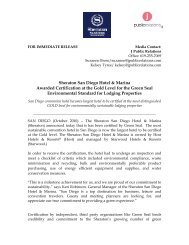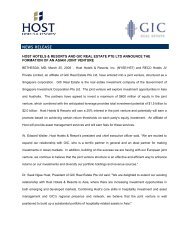Host Marriott 2004 Annual Report - Host Hotels & Resorts, Inc
Host Marriott 2004 Annual Report - Host Hotels & Resorts, Inc
Host Marriott 2004 Annual Report - Host Hotels & Resorts, Inc
You also want an ePaper? Increase the reach of your titles
YUMPU automatically turns print PDFs into web optimized ePapers that Google loves.
MANAGEMENT’S DISCUSSION AND ANALYSIS OF RESULTS OF<br />
OPERATIONS AND FINANCIAL CONDITION<br />
The following discussion should be read in conjunction with the<br />
consolidated financial statements and related notes included<br />
elsewhere in this report. This discussion contains forwardlooking<br />
statements about our business. These statements are<br />
based on current expectations and assumptions that are subject<br />
to risks and uncertainties. Actual results could differ materially<br />
because of factors discussed in “Forward Looking Statements”<br />
contained in this report.<br />
OVERVIEW<br />
STRUCTURE AND BUSINESS<br />
We own 107 full-service luxury and upper-upscale hotel<br />
properties and, as of February 28, 2005, <strong>Host</strong> <strong>Marriott</strong><br />
Corporation was the largest hotel real estate investment trust,<br />
or REIT, in the National Association of Real Estate Investment<br />
Trust’s composite index. A REIT is a legal entity that holds real<br />
estate interests and, through payments of dividends to stockholders,<br />
is permitted to reduce or avoid federal income taxes at<br />
the corporate level. <strong>Host</strong> <strong>Marriott</strong> operates as a self-managed<br />
and self-administered REIT, which means that we are managed<br />
by a board of directors and executive officers. We conduct<br />
our operations through <strong>Host</strong> <strong>Marriott</strong>, L.P. (“<strong>Host</strong> LP,” or the<br />
“operating partnership”) and its subsidiaries, which hold<br />
substantially all of our assets. <strong>Host</strong> <strong>Marriott</strong> is the sole general<br />
partner of <strong>Host</strong> LP and owns approximately 94% of the operating<br />
partnership interests, or OP Units.<br />
Our hotels are operated under brand names that are among<br />
the most respected and widely recognized in the lodging<br />
industry—including <strong>Marriott</strong>®, Ritz-Carlton®, Hyatt®, Four<br />
Seasons®, Fairmont®, Hilton®, and Westin®. Approximately 85%<br />
of our hotels (as measured by sales) are managed by <strong>Marriott</strong><br />
International or its affiliates and branded under the <strong>Marriott</strong><br />
or Ritz-Carlton brand names. The majority of our properties<br />
are located in central business districts of major cities, near<br />
airports and in resort/conference locations. The target profile<br />
for our portfolio includes luxury and upper-upscale full-service<br />
properties in urban and resort/conference locations which<br />
benefit from significant barriers to entry by competitors.<br />
Though hotels meeting this target profile will still be subject to<br />
competitive pressures, we believe this will allow us to maintain<br />
room rate and occupancy premiums over our competitors. We<br />
also seek to maximize the value of our portfolio through<br />
aggressive asset management, by assisting the managers of our<br />
hotels in maximizing property operations and by completing<br />
strategic capital improvements. The majority of our customers<br />
fall into three broad groups: transient business, group business,<br />
and contract business (approximately 54%, 43% and<br />
3%, respectively, of our business in <strong>2004</strong>). Our transient<br />
business, which includes the individual corporate and leisure<br />
traveler, is generally accommodated at a premium rate when<br />
compared to other customer types. Group business includes<br />
hotel bookings related to conferences and events. The remainder<br />
of our customer base results from contracts for a specified<br />
number of rooms over a fixed period.<br />
Our hotels are operated by third-party managers under<br />
long-term agreements under which they earn base and incentive<br />
management fees related to revenues and profitability of<br />
each individual hotel. We provide operating funds, or working<br />
capital, which the managers use to operate the property<br />
including purchasing inventory and paying wages, utilities,<br />
property taxes and other expenses. We generally receive a cash<br />
distribution, which reflects hotel-level sales less propertylevel<br />
operating expenses (excluding depreciation), from our<br />
hotel managers each four week or monthly accounting period,<br />
depending on the manager.<br />
Hotel revenue is approximately 97% of our total revenue.<br />
The following table presents the components of our hotel<br />
revenue as a percentage of our total revenue:<br />
% OF <strong>2004</strong> REVENUES<br />
Rooms revenue. Occupancy and average daily room rate are the major drivers of rooms revenue. The business mix of<br />
the hotel (group versus transient and premium versus discount business) is the key driver of room rates. 59%<br />
Food and beverage revenue. Occupancy and the type of customer staying at the hotel are the major drivers of food and<br />
beverage revenue (i.e., group business typically generates more food and beverage business through catering functions<br />
when compared to transient business, which may or may not utilize the restaurant outlets). 31%<br />
Other revenue. Occupancy, the nature of the property (i.e., resort, etc.) and its price point are the main drivers of other<br />
ancillary revenue, such as parking, golf course, spa, telephone, entertainment and other guest services. 7%<br />
17<br />
HOST MARRIOTT <strong>2004</strong>








